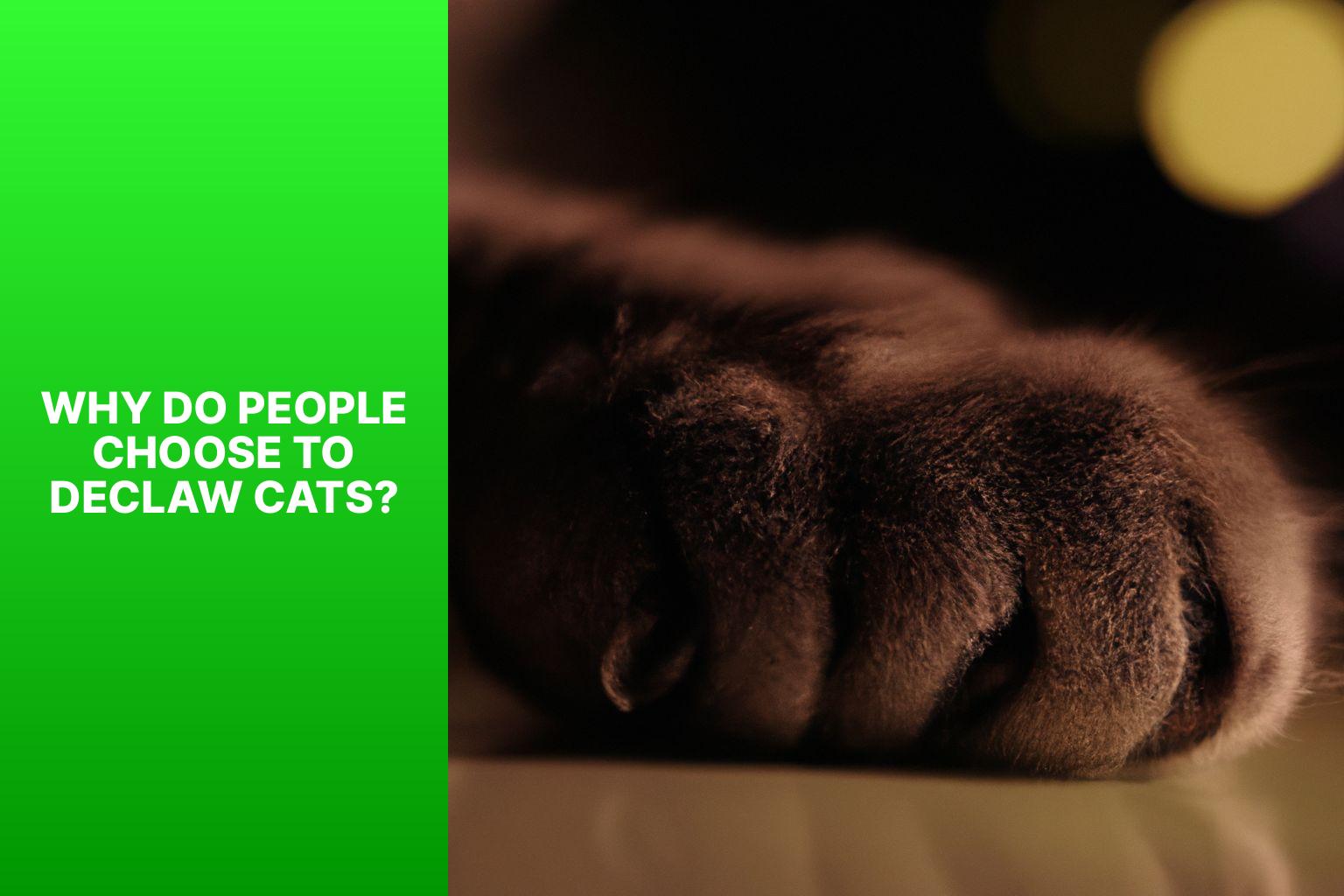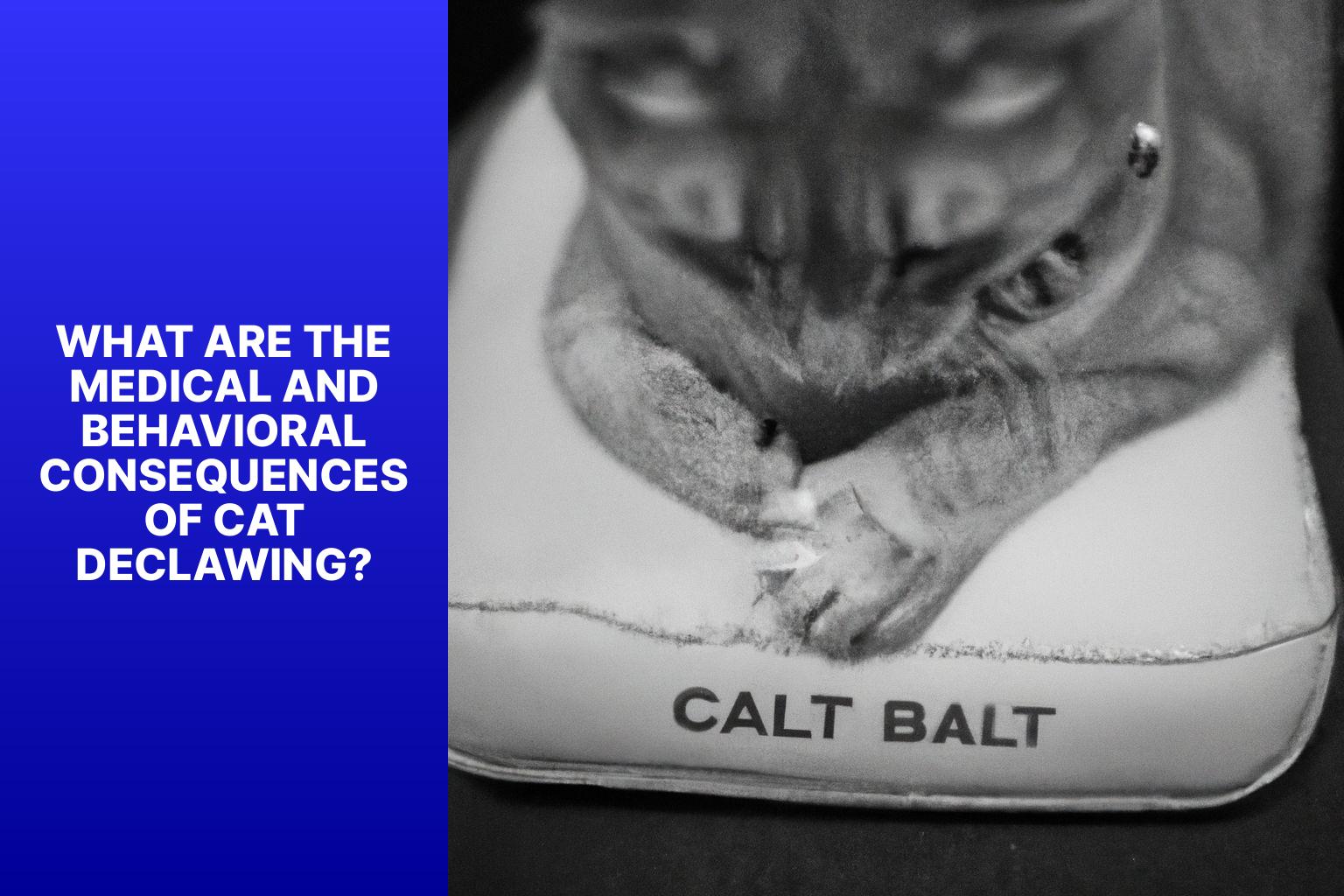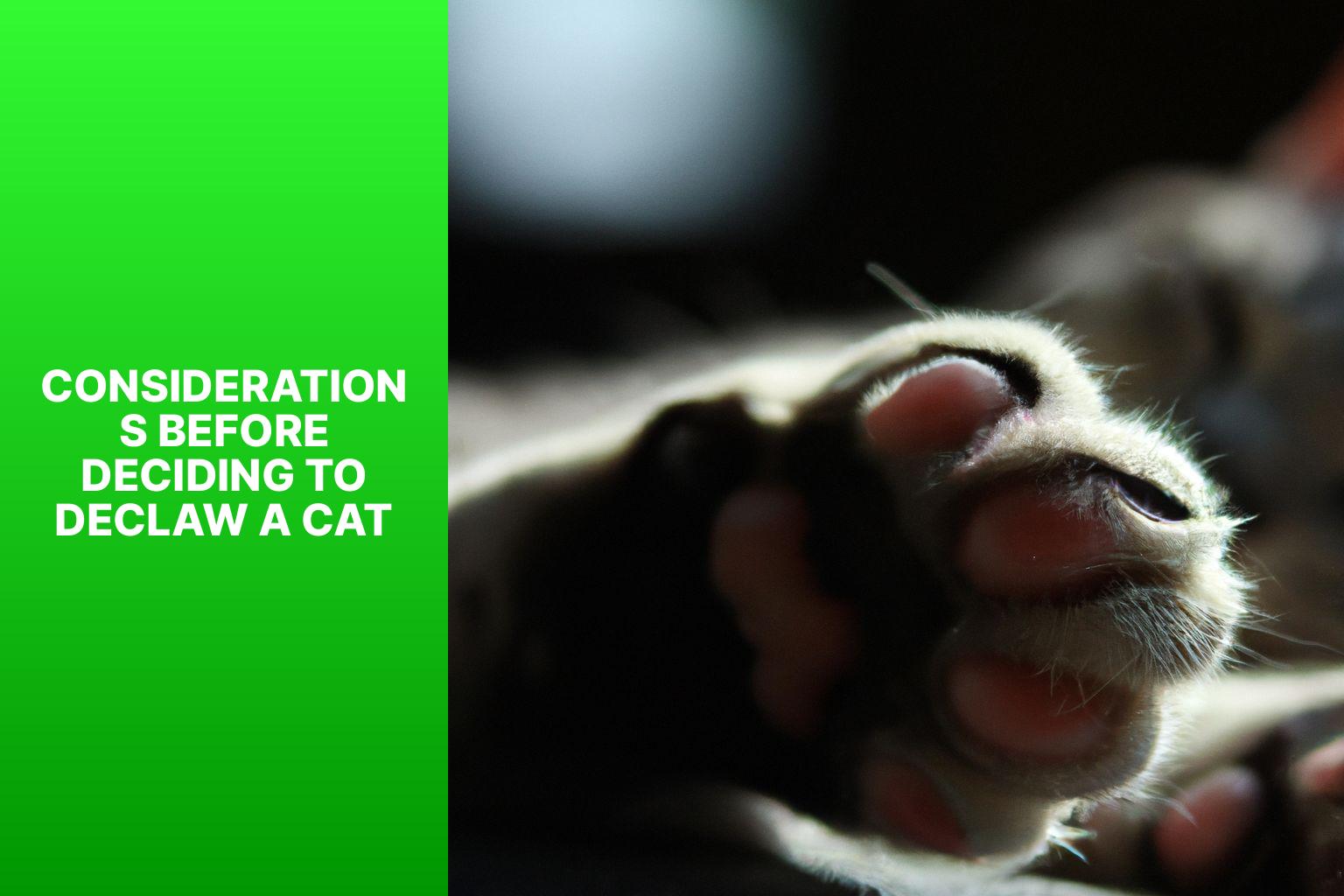Declawing a cat is a surgical procedure that involves the removal of a cat’s claws. It is a controversial practice with various perspectives and considerations. In this article, we will explore the process of cat declawing, the reasons why people choose to declaw their cats, the ethical concerns surrounding declawing, the potential medical and behavioral consequences, alternatives to declawing, and the cost associated with this procedure.
Cat declawing involves the amputation of the last bone of each toe, where the claw grows. It is typically done using either a surgical blade or a laser. The procedure is performed under anesthesia and may require a period of recovery.
People may choose to have their cats declawed for different reasons. One common reason is to protect furniture and belongings from scratching. Declawing can also be done for safety concerns, particularly if there are children or other pets in the household who may be scratched.
The ethical aspects of cat declawing are widely debated. Some argue that it is a cruel and unnecessary procedure that can cause pain and discomfort to the cat. Others believe that it can be a last resort option to prevent cats from engaging in destructive behavior.
There are potential medical and behavioral consequences associated with cat declawing. Pain and discomfort are common after the procedure, and there can be long-term behavioral changes as well. Cats may become more prone to biting or develop litter box aversion.
Before considering declawing, it is important to explore alternatives. There are various methods and strategies to discourage scratching behavior, such as providing appropriate scratching posts and regular nail trimming.
Understanding the cost of declawing a cat is also important. The cost can vary depending on factors such as the veterinarian’s fees, the region where the procedure is performed, and any additional services or medications required.
Before deciding to declaw a cat, it is essential to consider the importance of scratching for cats’ physical and emotional well-being. Exploring alternative options to declawing can help protect the cat’s natural instincts and behaviors.
In this article, we will delve into each of these aspects in detail, providing a comprehensive understanding of cat declawing and its implications.
Key takeaway:
- Cat declawing is a controversial procedure: Cat declawing involves removing a cat’s claws, which has ethical implications and potential medical and behavioral consequences.
- Factors affecting the cost of declawing: The cost of declawing a cat can vary depending on factors such as the veterinarian’s fees, geographical location, and additional services required.
- Considering alternatives and making an informed decision: It is important to understand the importance of scratching for cats and explore potential alternatives to declawing before deciding on the procedure.
What Does Cat Declawing Involve?
Cat declawing, also known as onychectomy, involves the surgical removal of a cat’s claws. This procedure is done to prevent cats from scratching furniture or people. It is important to understand the process and its implications on the cat’s well-being.
During the declawing procedure, the cat is placed under general anesthesia. The veterinarian then removes both the claw and the underlying bone responsible for its growth. To manage any discomfort after the surgery, the cat is prescribed pain medication.
Although declawing may seem like a solution, there can be potential complications. These complications include infection, bleeding, and lameness, which can hinder the cat’s ability to walk properly. Declawing can have negative long-term effects on the cat’s behavior, leading to increased aggression and a reluctance to use litter boxes.
It is crucial to note that declawing is not recommended or necessary for cats. There are numerous alternatives available to prevent scratching. Providing appropriate scratching posts and regularly trimming the cat’s nails are effective ways to address this behavior. These alternatives should always be explored before considering the drastic measure of declawing.
It is worth acknowledging that declawing cats is considered inhumane and has been banned in several countries and jurisdictions. For proper management of scratching behaviors in cats, it is always advisable to consult with a veterinarian or feline behavior specialist to explore other options. The well-being and welfare of the cat should be of utmost importance in any decision made regarding their claws.
Why Do People Choose to Declaw Cats?
Photo Credits: Www.Catcornerblog.Com by Harold King
Why do people choose to declaw their cats? Let’s explore the reasons behind this practice. From protecting furniture and belongings to addressing safety concerns for children and other pets, there are various factors that come into play. So, why do some cat owners opt for this procedure? Let’s dive into the motivations and considerations behind the choice to declaw and understand the impact it can have on both cats and their owners. Stick around to uncover the fascinating insights on this controversial subject.
Protecting Furniture and Belongings
To protect furniture and belongings from a cat’s scratching behavior, consider these options:
- Offer scratching posts or boards: Redirect your cat’s scratching behavior by providing appropriate places for them to scratch, such as scratching posts or boards.
- Use deterrents: Discourage your cat from scratching furniture by using double-sided tape, aluminum foil, or citrus scents.
- Trim your cat’s nails: Minimize furniture damage by regularly trimming your cat’s nails. Consult your veterinarian for guidance on safe nail trimming techniques.
- Provide alternative materials: Divert your cat’s attention from furniture by offering alternative materials to scratch, like sisal rope or cardboard scratching pads.
Fact: Scratching is a normal and necessary behavior for cats to maintain claw health, stretch muscles, and mark territory.[1]
Safety Concerns for Children and Other Pets
Cat declawing can pose safety concerns for children and other pets in the household.
Here are some factors to consider:
1. Scratching as a defense mechanism: Cats use their claws to defend themselves. Without claws, they may resort to biting or other aggressive behaviors, which can be a safety concern for children who may not understand how to interact with a declawed cat.
2. Playful behavior: Cats and children often engage in playful interactions that involve scratching and gentle swatting. Declawed cats may still try to engage in these behaviors, but without claws, it can lead to frustration and potential injury for both the child and the cat.
3. Interactions with other pets: Other pets in the household, such as dogs or other cats, may engage in rough play or dominance behavior. Declawed cats may be at a disadvantage in these interactions, as they are unable to defend themselves appropriately.
4. Adjustment period: After declawing, cats need time to heal and adjust to their altered anatomy. During this time, they may be more vulnerable and less able to protect themselves. It is important to provide a safe environment for them to recover.
Considering these safety concerns, it is crucial to explore alternatives to cat declawing. Providing appropriate scratching posts, regular nail trims, and positive reinforcement training can help redirect a cat’s scratching behavior in a safe and non-harmful manner. By understanding and addressing these safety concerns, you can make an informed decision that prioritizes the well-being and safety of everyone in your home.
Is Declawing a Cat Ethical?
“Is Declawing a Cat Ethical?”
Declawing a cat is considered inhumane and unnecessary, making it an unethical practice. Surgically removing the cat’s claws causes significant pain, discomfort, and can result in long-term chronic issues for the cat. Declawing can lead to behavioral problems as cats rely on their claws for stretching, hunting, and self-defense. Removing their claws takes away their primary means of self-defense.
Declawing goes against the natural instincts and needs of cats. To promote natural behaviors and maintain healthy and trimmed claws, it is important to provide appropriate scratching posts and toys. Regular nail trimming and offering alternatives to scratching furniture can effectively address concerns about destructive behavior.
Instead of declawing, there are more humane alternatives available. These alternatives include behavioral training, nail trimming, using soft nail caps, or providing appropriate scratching surfaces. By utilizing these alternatives, cats are able to maintain their natural behaviors while also protecting furniture and other household items.
What Are the Medical and Behavioral Consequences of Cat Declawing?
Photo Credits: Www.Catcornerblog.Com by Austin Wright
Declawing a cat may seem like a simple solution, but have you considered the medical and behavioral consequences? In this section, we’ll uncover the truth behind cat declawing and its impact on our feline friends. From the pain and discomfort they endure to the behavioral changes they may develop, we’ll explore the facts that every cat owner should know. So, before you make a decision, let’s delve into the hidden side of cat declawing.
Pain and Discomfort
Cat declawing inflicts pain and discomfort upon feline companions. This procedure involves amputating the final bone of each toe, leading to intense postoperative pain that can persist for days or even weeks. Throughout this duration, cats may display signs of discomfort such as limping, reluctance to walk or play, and sensitivity to touch. Activities like jumping or scratching can exacerbate their distress.
Cats may suffer from chronic pain as a result of nerve damage and alterations in weight distribution following the surgery. These issues can affect their overall mobility and gait. The healing process itself can be quite painful due to cats’ susceptible toes, making them more susceptible to infections.
It is crucial to recognize that cats heavily rely on their claws for essential activities such as hunting, climbing, and self-defense. Declawing undermines these innate instincts, thereby compounding their distress and discomfort. Considering the immense pain and discomfort associated with cat declawing, it is deemed an unethical practice that should be avoided.
Rather than resorting to declawing, there exist alternative options to address scratching concerns. These alternatives encompass providing suitable scratching posts, regular nail trimming, and employing soft nail caps. Unlike declawing, these alternatives do not inflict any pain upon cats, enabling them to engage in their natural behaviors free from discomfort.
Behavioral Changes
Cat declawing can cause significant behavioral changes. After the procedure, cats may experience behavioral changes such as increased aggression and a tendency to bite instead of scratch.
Declawed cats may develop fear and anxiety due to their inability to climb or escape from potential threats. Consequently, their overall well-being and quality of life may diminish.
It’s essential to note that not all declawed cats will exhibit these behavioral changes. It is crucial to consider this potential consequence before deciding to declaw.
Owners must understand that scratching is a natural and necessary behavior for cats. Declawing interferes with this instinctual behavior, leading to negative physiological and psychological effects.
To prevent these behavioral changes, it is important to explore alternative solutions. Providing appropriate scratching posts, regular nail care, and behavioral training can redirect a cat’s scratching behavior in a more suitable manner. These alternatives promote the well-being of the cat and minimize any negative consequences associated with declawing.
Alternatives to Cat Declawing
Alternatives to Cat Declawing
Scratching Posts: Provide your cat with a scratching post to redirect their behavior. Choose a sturdy post covered in rough fabric for optimal satisfaction.
Nail Trimming: Regularly trim your cat’s nails to reduce the need for declawing. Use cat-specific nail clippers and be careful not to cut into the quick. If unsure, consult a veterinarian or groomer.
Nail Caps: Apply soft caps to your cat’s claws to prevent damage. These caps naturally shed as the nails grow. Follow instructions and check regularly.
Positive Reinforcement: Reward your cat for using scratching posts and discourage scratching furniture. Offer treats, praise, and playtime for desired behavior.
Pro-tip: Remember that scratching is natural for cats. Providing alternatives and positive reinforcement helps maintain a happy and well-behaved feline companion.
Understanding the Cost of Declawing a Cat
Photo Credits: Www.Catcornerblog.Com by Jonathan Hernandez
Declawing a cat may come at a cost, but have you ever wondered what factors influence that cost and what the price range entails? Delve into the understanding of the cost of declawing a cat as we explore the various factors affecting the expenses involved and shed light on the range of costs you can expect. Get ready to gain insights into this contentious topic and make informed decisions regarding your feline friend’s well-being.
Factors Affecting Cost
The cost of declawing a cat can be influenced by various factors, including geographic location, veterinarian experience, type of clinic or hospital, and additional procedures. In urban areas, prices tend to be higher than in rural areas. Veterinarians with more experience may charge higher fees. Specialized veterinary hospitals may also have higher prices compared to general clinics. If additional procedures, such as spaying or neutering, are carried out simultaneously with declawing, it can increase the overall cost. Familiarizing oneself with these factors can help cat owners estimate the cost of declawing and make an informed decision. It is crucial to consider the financial implications, as well as ethical and medical considerations, before opting for cat declawing. Seeking advice from a veterinarian can provide accurate cost estimates and explore alternative options that may be more humane and cost-effective.
Range of Costs
The costs for declawing a cat can vary depending on factors like the type of procedure, geographic location, and any medical complications.
Here is a table outlining the range of costs associated with cat declawing:
| Factor | Range of Costs |
|---|---|
| Type of Procedure | $100-$500 |
| Geographic Location | $50-$200 |
| Medical Complications | $200-$500 |
| Pre-Operative Examination | $50-$100 |
| Post-Operative Medications | $20-$100 |
| Overnight Stay (if needed) | $50-$200 |
It’s important to note that these are just average costs and actual prices may vary. The type of procedure chosen and the location of the veterinary clinic or hospital can affect the cost. Additional costs may be incurred if there are any complications during or after the procedure. Pre-operative examinations and post-operative medications are usually included in the cost, but it’s important to confirm with the veterinarian. If an overnight stay is necessary, there may be an extra charge.
When considering the cost of cat declawing, it’s important to remember that it is a surgical procedure involving the removal of the cat’s claws. It’s a major decision that should be made after considering the potential consequences and alternatives. Consultation with a veterinarian is recommended to make an informed decision that prioritizes the cat’s well-being and welfare.
Considerations Before Deciding to Declaw a Cat
Photo Credits: Www.Catcornerblog.Com by Edward Smith
Considering whether to declaw a cat involves important considerations. We’ll explore the significance of scratching for cats and discover potential alternatives to declawing. Did you know that scratching is a natural and necessary behavior for felines? Understanding the benefits it provides is crucial. We’ll delve into alternative methods that can provide cats with an outlet for their scratching instincts. By examining these key aspects, we can make informed decisions that prioritize the well-being and happiness of our feline friends.
The Importance of Scratching for Cats
The importance of scratching for cats is incredibly significant. Scratching serves important purposes for cats. Scratching allows cats to mark their territory visually and through scent. Cats have scent glands on their paws, so when they scratch, they leave scent markers that communicate to other cats that the area is already claimed.
Scratching helps cats shed the dead outer layer of their claws, keeping them sharp and healthy. It also stretches and flexes their muscles, promoting overall physical well-being. Scratching provides cats with a way to relieve stress and release pent-up energy. It can be a form of exercise and mental stimulation for them, which is crucial for their overall well-being.
Scratching can also be a way for cats to communicate with their owners and other cats. Cats may scratch in front of their owners to get attention or to indicate their presence. It can also serve as a social bonding activity when cats scratch together.
Pro-tip: To encourage appropriate scratching behavior, provide cats with suitable scratching posts or boards and regularly trim their nails. Positive reinforcement and rewards can also be used when they use the designated scratching areas.
Potential Alternatives to Declawing
Potential alternatives to declawing cats include:
- Regular nail trims: Trim your cat’s nails to prevent damage to furniture and belongings. This can be done at home or by a professional groomer.
- Scratching posts: Provide your cat with plenty of scratching posts to redirect their natural instinct to scratch towards acceptable surfaces.
- Nail caps: Apply soft rubber nail caps to your cat’s claws to prevent scratching. These caps are safe and painless and can be replaced as needed.
- Positive reinforcement training: Use positive reinforcement techniques to teach your cat to scratch appropriate surfaces and redirect their behavior away from furniture.
- Environmental enrichment: Provide your cat with a stimulating environment that includes toys, perches, and hiding spots to reduce boredom and the need for scratching.
Potential alternatives to declawing cats have become more popular due to increased awareness of ethical concerns and negative consequences. These alternatives focus on providing cats with appropriate outlets for scratching behavior while also protecting furniture and belongings. It is important to remember that declawing is a painful and irreversible procedure that can cause behavioral changes in cats. By exploring and utilizing these alternative options, cat owners can ensure the well-being and happiness of their pets while maintaining a harmonious living environment.
Some Facts About How Much Does It Cost To Declaw a Cat:
- ✅ Declawing cats is legal in the United States and Canada. (Source: Our Team)
- ✅ Many vets suggest alternatives to declawing such as nail trims, training, and nail caps. (Source: Our Team)
- ✅ Declawing a cat involves amputating the nail bed of each front toe and can result in complications. (Source: Our Team)
- ✅ The cost of declawing a cat can range from $200 to $1800. (Source: Our Team)
- ✅ There are alternative options to declawing, such as providing proper training and scratching posts. (Source: Our Team)









